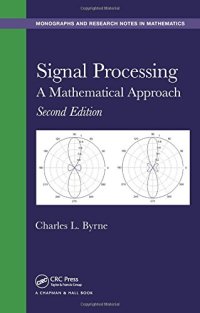
Ebook: Signal Processing: A Mathematical Approach
Author: Charles L. Byrne
- Genre: Mathematics // Wavelets and signal processing
- Series: Monographs and Research Notes in Mathematics
- Year: 2014
- Publisher: Chapman and Hall/CRC
- Edition: 2
- Language: English
- pdf
Features
Explains how mathematical tools can be used to solve problems in signal processing
Assumes an advanced undergraduate- or graduate-level understanding of mathematics
Includes robust appendices and problems for classroom use
Signal Processing: A Mathematical Approach is designed to show how many of the mathematical tools the reader knows can be used to understand and employ signal processing techniques in an applied environment. Assuming an advanced undergraduate- or graduate-level understanding of mathematics—including familiarity with Fourier series, matrices, probability, and statistics—this Second Edition:
Contains new chapters on convolution and the vector DFT, plane-wave propagation, and the BLUE and Kalman filters
Expands the material on Fourier analysis to three new chapters to provide additional background information
Presents real-world examples of applications that demonstrate how mathematics is used in remote sensing
Featuring problems for use in the classroom or practice, Signal Processing: A Mathematical Approach, Second Edition covers topics such as Fourier series and transforms in one and several variables; applications to acoustic and electro-magnetic propagation models, transmission and emission tomography, and image reconstruction; sampling and the limited data problem; matrix methods, singular value decomposition, and data compression; optimization techniques in signal and image reconstruction from projections; autocorrelations and power spectra; high-resolution methods; detection and optimal filtering; and eigenvector-based methods for array processing and statistical filtering, time-frequency analysis, and wavelets.
Explains how mathematical tools can be used to solve problems in signal processing
Assumes an advanced undergraduate- or graduate-level understanding of mathematics
Includes robust appendices and problems for classroom use
Signal Processing: A Mathematical Approach is designed to show how many of the mathematical tools the reader knows can be used to understand and employ signal processing techniques in an applied environment. Assuming an advanced undergraduate- or graduate-level understanding of mathematics—including familiarity with Fourier series, matrices, probability, and statistics—this Second Edition:
Contains new chapters on convolution and the vector DFT, plane-wave propagation, and the BLUE and Kalman filters
Expands the material on Fourier analysis to three new chapters to provide additional background information
Presents real-world examples of applications that demonstrate how mathematics is used in remote sensing
Featuring problems for use in the classroom or practice, Signal Processing: A Mathematical Approach, Second Edition covers topics such as Fourier series and transforms in one and several variables; applications to acoustic and electro-magnetic propagation models, transmission and emission tomography, and image reconstruction; sampling and the limited data problem; matrix methods, singular value decomposition, and data compression; optimization techniques in signal and image reconstruction from projections; autocorrelations and power spectra; high-resolution methods; detection and optimal filtering; and eigenvector-based methods for array processing and statistical filtering, time-frequency analysis, and wavelets.
Download the book Signal Processing: A Mathematical Approach for free or read online
Continue reading on any device:

Last viewed books
Related books
{related-news}
Comments (0)